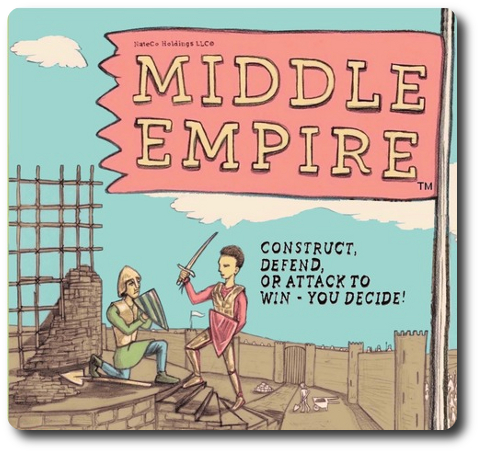
The Basics:
- For ages 8 and up (publisher suggests 13+)
- For 2 to 4 players
- Approximately 30 minutes to complete
Geek Skills:
- Counting & Math
- Logical & Critical Decision Making
- Reading
- Strategy & Tactics
- Hand/Resource Management
- Area Control
Learning Curve:
- Child – Easy
- Adult – Easy
Theme & Narrative:
- Build an empire from the ground up
Endorsements:
- Gamer Geek rejected!
- Parent Geek mixed!
- Child Geek approved!
Overview
British politician and statesman, Joseph Chamberlain, said “The day of small nations has long passed away. The day of Empires has come.” Ambition is a powerful motivator that will lead men and women to take questionable risks. In this game, players will build their own empire in a hostile land that seeks to crush them.
Middle Empire, designed by Nathan White and published by NateCo Holdings, is comprised of 1 game board, 16 Empire pieces (4 each in the colors red, black, green, and white), 36 Stronghold pieces (9 each in the colors red, black, green, and white), 40 Road pieces (10 each in the colors red, black, green, and white), 6 City Wall pieces, 38 Construction cards, 37 Defense cards, and 20 Attack cards.The pieces are made of solid wood and painted. The cards are as thick and as durable as your standard playing card. The game board is made of thick cardboard and depicts the Mesopotamia region and the surrounding area.
Preparing Your Empire
To set up the game, first place the game board in the middle of the playing area and within easy reach of all the players.
Second, have each player select a color of their choice and take 4 Empire pieces, 9 Stronghold pieces, and 10 Road pieces of the same color. Place any pieces not used back in the game box.
Third, place the City Wall pieces to one side of the game board and within easy reach of all the players.
Fourth, separate the cards by type (Construction, Defense, and Attack), making a pile for each. Shuffle each card pile. Deal 3 Construction cards, 1 Defense card, and 1 Attack card to each player, face-down. This is the player’s starting hand. Players should feel free to look at their cards, but should keep them hidden until played.
Fifth, place each pile of cards in their designated area on the game board, face-down. These are the Construction, Defense, and Attack draw decks for the duration of the game.
That’s it for game set up. Determine who will go first and begin.
A Castle of Cards
Middle Empire uses cards to determine what actions the player can take. Each of the different card types are summarized here.
Construction Cards
These cards allow the player to place a Stronghold piece and upgrade Strongholds to Empire pieces. The majority of the Construction cards have a named region which allow construction in those specific areas. This means it’s relatively simple to build a Stronghold, but significantly more difficult to build an Empire. To offset some of the difficulty involved, there are also a small number of “Wild” Construction cards that can be used in any region to build a Stronghold or an Empire. There is also one very special Construction card that allows the player to upgrade one Stronghold to an Empire.
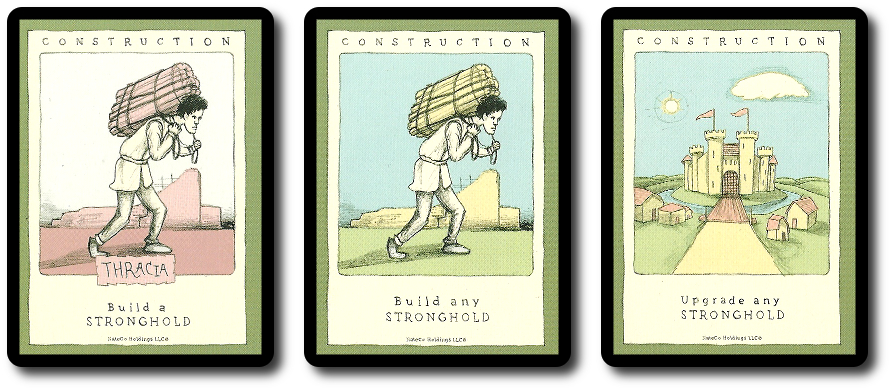
Defense Cards
After building a Stronghold or an Empire, a player will want to defend it from their opponents who want the territory they occupy. This is done through Defense cards. Defense cards can build roads to quickly connect the player’s army to key regions, build a City Wall piece around a successfully established Empires, and defend against an opponent’s armies. There are some Defense cards that also allow the player to draw more cards, ensuring they always have options.
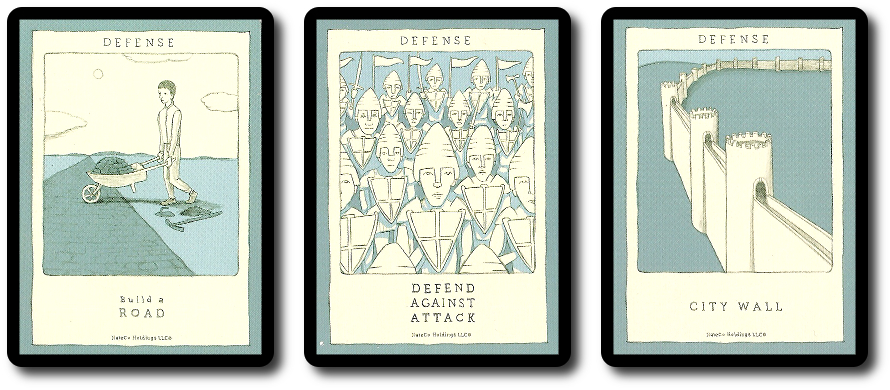
Attack Cards
After building an empire and fortifying it, it’s time to look beyond the player’s boarders and consider removing the threat of distant Empires. Attack cards can remove or relocate roads, changing how different civilizations connect to each other or attack an opponent directly. There are a few Attack cards that even allow the player to attack twice on a single turn, which may lead to an entire Empire being erased from the map.
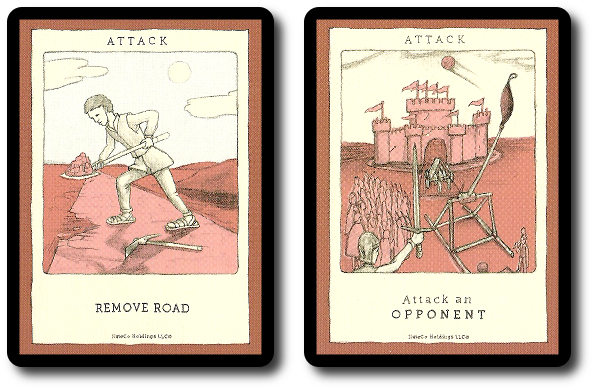
Building Your Empire
Middle Empire is played in turns with no set number of turns per game. A player’s turn is summarized here.
Step 1: Draw Cards
The first action the player takes on their turn is adding cards to their hand. The player can only take 2 cards, but those 2 cards can be from any draw piles. Possible combinations include the following:
- 2 Construction cards
- 2 Defense cards
- 2 Attack cards
- 1 Construction card / 1 Defense card
- 1 Construction card / 1 Attack card
- 1 Attack card / 1 Defense card
Once the cards are drawn, they are added to the player’s hand. A player can draw 1 card, look at it, and then draw their second.
Step 2: Play Cards
A player can now optionally play any of their cards up to a maximum of 3 cards played per turn. Additionally, a player can only play 1 card of each type (Construction, Defense, and Attack) per turn, meaning a player cannot construct a Stronghold and Empire on the same turn.They could, however, upgrade a Stronghold to an Empire, build a Road, and then Attack an opponent.
When cards are played, they are read out loud, resolved, and then discarded face-up in the appropriate discard pile.
Step 3: Ending the Turn
After the player completes their second step by playing 3 or fewer cards (or none at all, as step 2 is optional), the player must discard down to a hand size of no more than 7 cards. Discarded cards are placed in the correct discard piles, but are instead placed face-down, not face-up. Cards not played remain a mystery.
Construction and Destruction
A player must first place their cube Stronghold piece in an empty region of the game board using either a Construction card with the name of the region printed on it or by using a “Wild” Construction card (which allows the building of a Stronghold in any empty region). After building the Stronghold, the next goal should be to upgrade the Stronghold to an Empire. This is done by repeating the building processes by using Construction cards, except that any region where the player builds that already contains a Stronghold now becomes an Empire.
A player’s Stronghold might be the target of an opponent, but a player’s Empire will most certainly be susceptible to attacks from multiple opponents. This is because Empires are needed to win the game, and if the player has an Empire, they are a real threat to their opponents. A player can protect their Empire by building a City Wall piece, requiring the player’s opponents to attack the Empire piece twice to make it tumble.
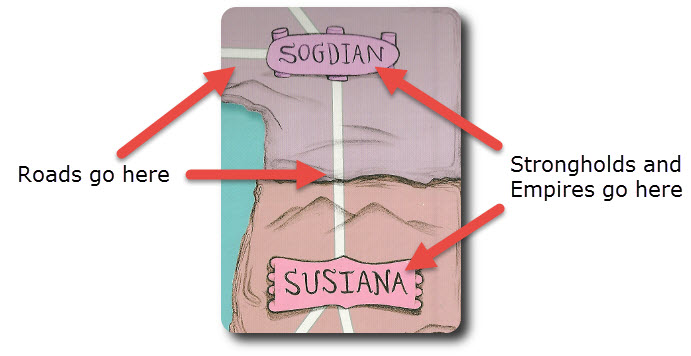
Building roads is not only a good idea, but necessary to move an army from one region to another. The Road pieces start at a player’s Stronghold or Empire and eventually connect to an opponent’s Stronghold or Empire. As long as the road connects, the player can attack that region. Caution should be taken, however, as Road pieces are a limited resource. A player may find that they stretch themselves too thin and leave themselves open to attacks without means to counter. Furthermore, Road pieces remain in play after a player’s Stronghold or Empire falls.
Anything you build in the game can be destroyed. This goes for Roads, Walls, Strongholds and Empires. When a player attacks a Stronghold, they only need 1 unblocked attack to successfully burn the Stronghold to the ground and remove it from the game board. An Empire is also just as easy to remove, but an Empire can be fortified with walls, making it more difficult to topple. Finally the Road pieces can be removed, making attacks impossible.
In the end, this game is all about knowing where to build and when. Build without the means to defend, and a player will be left with nothing to show for their efforts. A smart player who knows that one should build towards one’s goals will most certainly do well in the game.
Empire of All
The game continues until a player is able to successfully construct a predetermined number of Empires. The number to be built is based on the number of players in the game. For example, a 2-player game requires players to construct 4 Empires to win and a 4-player game requires players to construct only 2 Empires to win.
To learn more about Middle Empire, visit the game’s web page.
Final Word
The Child Geeks quickly learned and got to playing the game, demonstrating smart card choices and plays. However, the game’s tempo only seemed to drop the longer the game continued. As one Child Geek put it, “The game starts out pretty fast, but the longer you play it, the more you realize how dependent you are on having the right cards.” The rules that state that only 1 card of each type can be played per player’s turn was both a blessing and a curse. The more skilled Child Geeks found the card play rules to be oftentimes too restrictive, while the younger Child Geeks found the rules to be exceedingly helpful. As one younger Child Geek put it, “The game rules really help you learn how to play and play to win.” When all the Empires were built and roads paved, the Child Geeks decided that Middle Empire was a game they enjoyed playing, despite being frustrated at times.
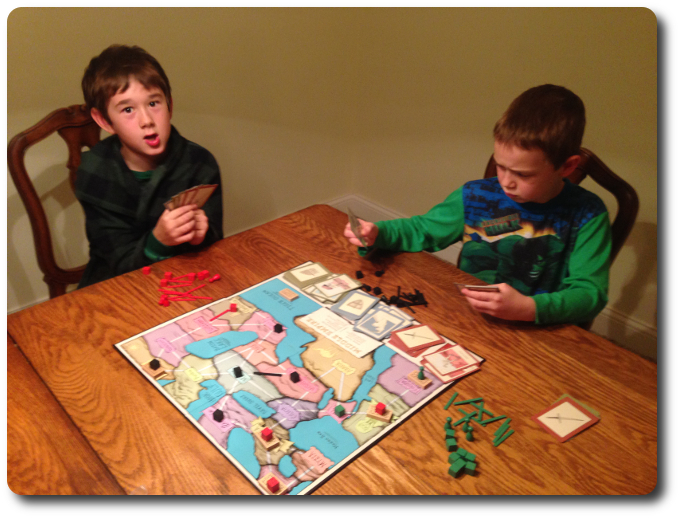
There wasn’t much in the way of downtime, but the more experienced Child Geeks got tired of waiting
The Parent Geeks quickly identified many of the restrictions that the Child Geeks did. The card type limit was a topic of much negative discussion, as was the restricted methods of attacking opponents. According to one Parent Geek, “The game has some very good ideas and I think they all work, but it feels way too restrictive and regulated.” Another Parent Geek said, “I think this is the perfect game to put in front of new players and non-gamers because it all makes sense. But for more serious players who are looking to bend or break the rules, the game does not allow even an inch of creative play.” In general, the Parent Geeks found Middle Empire to be a game they enjoyed playing with their children and with friends and family who were not big into games, hailing Middle Empire as a great “gateway game”. The same could not be said about playing the game with other Parent Geeks or with family members who were familiar with games already and were more accustomed to being allowed to explore and define their own strategies and tactics. The end result was a mixed approval from the Parent Geek group.
The Gamer Geeks found faults with Middle Empire from the very start. To begin with, they greatly disliked that everything was card driven. All possible actions were based on what few cards the player had. If the player didn’t have good cards, the player couldn’t make good plays. Second, the Gamer Geeks found the limits placed on the number of card types to be dreadful. None of them understood why a player couldn’t build a Stronghold in two different locations on the map at the same time. Third, the Gamer Geeks found the requirement for Roads to attack to be terrible. According to one Gamer Geek, “It makes zero sense that the player must have a road of their color to attack an opponent and then force the opponent to demolish the road and build their own to attack back.” Again and again, the Gamer Geeks raised their eyebrows and shook their head in bewilderment, not understanding the reasons behind the game rules. As one Gamer Geek put it, “The game unnecessarily and often restricts the players to a point where the game is no fun to play whatsoever.” The Gamer Geeks voted to reject Middle Empire.
Middle Empire is the perfect game to put in front of players who are inexperienced or non-gamers. It is, in many ways, a “gateway game”. Which is to say, it introduces concept and game play that are common to many other games that are much more complex. The game itself is not overly difficult and more or less puts the player on a path from which they can determine their own destiny without getting lost along the way. Combining the easy learning curve and the well-defined boundaries of what a player can and cannot do immediately empowers the player to take control, take charge, and carve out their own Empire on the game board.
The game’s ease of play and limitations, however, are considered negatives by those who have played a great number of games. But the same could be said about the same players and their point-of-view of Hungry Hungry Hippos. The value of this game is based purely on the individual’s unique and subjective point-of-view, which is primarily defined by their own game playing experience. Middle Empire is not the kind of game you put in front of a player who goes to gaming conventions and has their own gaming group. It is a game you put in front of players who are just now getting tired of Monopoly or Uno. Which is to say, Middle Empire is a step into other games. To which the game designer and the game itself have done great job providing.
The game’s greatest weakness is the cards. If a player doesn’t have the right cards, they can do little on their turn. Further more, the restrictions on how many cards can be played keeps a player’s ambitions in check and regulates them to make small advances on their turn instead of hard pushes. This frustrated many and angered a few. Having the ability to make a sizable dent in the game, but being restricted by the game that wants you play, doesn’t feel very good. This was noted more than once by many of our players and was seen as the game’s most significant flaw.
While Middle Empire was of little interest to me, I do praise and recommend it to anyone who is looking to introduce players to games that involved civilization building, card management, and critical thinking. The game does a wonderful job of introducing some very basic and important game playing concepts in a way that is easy to understand and fun to learn. It lacks the depth, strategic game play, and tactical decision making to appease more experienced gamers, but this audience was never part of the game’s goal. For everyone else, Middle Empire should be an entertaining and rewarding experience, opening up new opportunities and fun.
This game was given to Father Geek as a review copy. Father Geek was not paid, bribed, wined, dined, or threatened in vain hopes of influencing this review. Such is the statuesque and legendary integrity of Father Geek.



